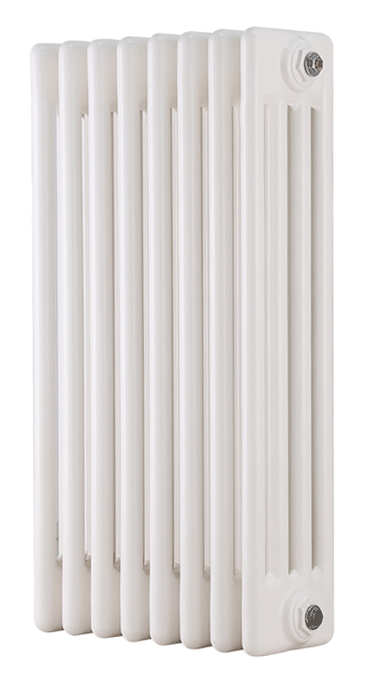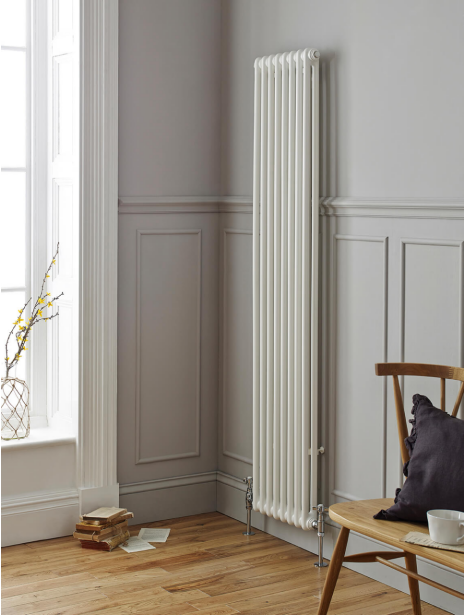Some people argue that cast iron radiators belong to the last century, but the reality demonstrates that they are still used on a large scale to this day, thanks to their unique features in terms of robustness and elegance.
This being said, steel-made radiators have replaced their cast iron counterparts in most places, from residential building, hotel and restaurant, library and gallery, all the way to factory and warehouse and others.
In this article we will take a closer look at cast iron radiators and steel column radiators and try to decipher their differences with numbers and figures.


Cast Iron Radiator Steel Column Radiator
Cast iron radiators are bulky and heavy
Compared with steel column radiators, cast iron radiators have thicker walls and are much heavier. For example, with a connection pitch of 19.7 inches, the weight of one section of a four-column steel radiator is 5.1 pounds, while the weight of one section of a cast iron radiator (slightly wider) is 11.2 pounds. In other words, a cast iron radiator weighs about twice as much as a steel column radiator of the same size.
Steel column radiators are more heat efficient and charge less on energy bills
With the same connection pitch of 19.7 inches, the steel column radiator of 5.5 inches width has a heat output of 112W, whereas the cast iron radiator of 6.3 inches width has a heat output of 88W. Customer feedback indicates that it takes much longer time for a cast iron radiator to warm a room than a steel column radiator, especially for large spaces. Also, more time to heat means more energy to consume, which leads to more charges on energy bills. Since heating constitutes a significant part of expenses for every home, replacing outdated cast iron radiators with modern steel ones equals sizable savings on house expenses.

Cast iron radiators are expensive to transport and install
Due to its heavy weight, cast iron radiators cost more in transportation, in terms of both human labor and road transport. Regarding the installation, accoring to our research, a professional HAVC installer from a state in northern America earns an hourly wage of 160 dollars for installing cast iron radiators and 100 dollars for installing steel column radiators. Affordable installation fees encourage customers to acquire and replace radiators in their home.

Cast iron radiators are more expensive than steel column radiators
With the models in our example, the price of one section of cast iron radiator is 7.8 dollars, whereas the price of one section of steel column radiator is 5.3 dollars. Steel column radiators clearly have an advantage in price, which will become greater if we aim to achieve the same effect in warming a room.
Steel column radiators are as reliable as cast iron radiators
Cast iron radiators are known to be robust thanks to their wall thickness. They can endure decades without water leakage. A less known fact is that steel column radiators of modern days can be as reliable. The typical working pressure of cast iron radiators is 6-8 bar, while that of steel column radiators falls in the same range. Compared with panel radiators made with steel sheets, column radiators come with a much more solid welding that ensures tight seal and prevents leagake.
Steel column radiators can be much higher than cast iron radiators
Upon need of customers, steel column radiators can be manufactured to reach the height of 94.5 inches or even more (example in image below), in order to satisfy different application requirements in special usage scenarios. By contrast, cast iron radiators never exceed 31 inches in height and therefore are not suitable for large spaces such as living rooms and lobbies.

Cast iron radiators are not suitable for different decor styles
Apart from quality and functionality, design is not to be neglected when choosing a radiator. Cast iron radiators have a particularly retro look to them, which makes them only suitable for certain decor styles. By contrast, steel column radiators present much more versatility with their looks. Their minimalist but clean and graceful design fits easily in various background. With steel column radiators customers no longer need to worry about clash of styles.
Conclusion
Reputed for their robustness and classic touch, cast iron radiators come with several disadvantages. In comparison, today’s steel column radiators not only combine aesthetic, versatility, functionality and reliability together, but also have better prices and lower cost of transport and installation. They have proven to be a better alternative, and for good reasons.